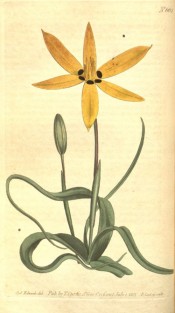Spiloxene capensis (L.) Garside
Half-hardy cormous perennial with erect, narrow, linear basal leaves and, in spring, solitary, upward-facing, white or yellow flowers, with bright purple or green basal spots. To 20cm. [RHSE, Hortus, CECB].
Horticultural & Botanical History
‘Flowers large, beautiful, expanding only when the sun shines; last several days; quite scentless; when closed have the appearance of a perianth. Should be kept in a small pot of light earth in the greenhouse; when the plant decays the bulbs should be kept dry, parted and replanted early in Autumn. Found at the Cape by Thunberg. Sent to the Kew Garden by Mr. Masson in 1778.’ [BM t.662/1803]. According to Flore des Serres it was introduced to Britain in 1752 by Miller at the Chelsea garden [FS f.1027/1855-56]. ‘The centre of the flower is of very rich colours, beautifully blended: it opens when the sun shines, but closes towards evening, each flower continuing to do this for several days.’ [LBC no.802/1824]. ‘This most brilliant variety of Hypoxis stellata [flore pleno] is as old an inhabitant of our gardens as [the single form]; it was likewise introduced by Mr. F. Masson.’ [ABR pl.236/c.1802]. A white-flowered form is figured at BM t.1223/1809. ABR pl.101/1800.
History at Camden Park
Listed only in the 1843 and 1845 catalogues.
Notes
Published Jan 19, 2009 - 04:28 PM | Last updated Jul 22, 2010 - 05:19 PM
| Family | Hypoxidaceae |
|---|---|
| Category | |
| Region of origin | South Africa |
| Synonyms |
|
| Common Name | Star flower |
| Name in the Camden Park Record | Hypoxis stellata |
| Confidence level | high |
